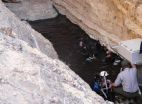(Press-News.org) How did the earliest birds take wing? Did they fall from trees and learn to flap their forelimbs to avoid crashing? Or did they run along the ground and pump their "arms" to get aloft?
The answer is buried 150 million years in the past, but a new University of California, Berkeley, study provides a new piece of evidence – birds have an innate ability to maneuver in midair, a talent that could have helped their ancestors learn to fly rather than fall from a perch.
The study looked at how baby birds, in this case chukar partridges, pheasant-like game birds from Eurasia, react when they fall upside down.
The researchers, Dennis Evangelista, now a postdoctoral researcher at the University of North Carolina, Chapel Hill, and Robert Dudley, UC Berkeley professor of integrative biology, found that even ungainly, day-old baby birds successfully use their flapping wings to right themselves when they fall from a nest, a skill that improves with age until they become coordinated and graceful flyers.
"From day one, post-hatching, 25 percent of these birds can basically roll in midair and land on their feet when you drop them," said Dudley, who also is affiliated with the Smithsonian Tropical Research Institute in Balboa, Panama. "This suggests that even rudimentary wings can serve a very useful aerodynamic purpose."
The nestlings right themselves by pumping their wings asymmetrically to flip or roll. By nine days after hatching, 100 percent of the birds in the study had developed coordinated or symmetric flapping, plus body pitch control to right themselves.
"These abilities develop very quickly after hatching, and occur before other previously described uses of the wings, such as for weight support during wing-assisted incline running," said Evangelista, who emphasized that no chukar chicks were injured in the process. "The results highlight the importance of maneuvering and control in development and evolution of flight in birds."
The researchers' study appeared Aug. 27 in the online journal Biology Letters, published by the Royal Society.
Dudley has argued for a decade that midair maneuverability preceded the development of flapping flight and allowed the ancestors of today's birds to effectively use their forelimbs as rudimentary wings. The new study shows that aerial righting using uncoordinated, asymmetric wing flapping is a very early development.
Righting behavior probably evolved because "nobody wants to be upside down, and it's particularly dangerous if you're falling in midair," Dudley said. "But once animals without wings have this innate aerial righting behavior, when wings came along it became easier, quicker and more efficient."
Dudley noted that some scientists hypothesize that true powered flight originated in the theropod dinosaurs, the ancestors to birds, when they used symmetric wing flapping while running up an incline, a behavior known as wing-assisted incline running, or WAIR. WAIR proponents argue that the wings assist running by providing lift, like the spoiler on a race car, and that the ability to steer or maneuver is absent early in evolution.
Such activity has never been regularly observed in nature, however, and Dudley favors the scenario that flight developed in tree-dwelling animals falling and eventually evolving the ability to glide and fly. He has documented many ways that animals in the wild, from lizards and lemurs to ants, use various parts of their bodies to avoid hard landings on the ground. Practically every animal that has been tested is able to turn upright, and a great many, even ones that do not look like fliers, have some ability to steer or maneuver in the air.
Contrary to WAIR, maneuvering is very important at all stages of flight evolution and must have been present early, Evangelista said. Seeing it develop first in very young chicks indirectly supports this idea.
"Symmetric flapping while running is certainly one possible context in which rudimentary wings could have been used, but it kicks in rather late in development relative to asymmetric flapping," Dudley added. "This experiment illustrates that there is a much broader range of aerodynamic capacity available for animals with these tiny, tiny wings than has been previously realized."
The researchers also tested the young chicks to see if they flapped their wings while running up an incline. None did.
INFORMATION:
Three former UC Berkeley undergraduates – Sharlene Cam, Tony Huynh and Igor Krivitskiy – worked with Evangelista and Dudley through the Undergraduate Research Apprentice Program (URAP) and are coauthors on the Biology Letters paper. Evangelista was supported by a National Science Foundation Integrative Graduate Education and Research Traineeship (IGERT #DGE-0903711) grant and by grants from the Berkeley Sigma Xi chapter and the national Sigma Xi.
Flapping baby birds give clues to origin of flight
Ability of chicks and other animals to right in midair suggests dinosaurs took flight from trees
2014-08-28
ELSE PRESS RELEASES FROM THIS DATE:
Prions can trigger 'stuck' wine fermentations, researchers find
2014-08-28
A chronic problem in winemaking is "stuck fermentation," when yeast that should be busily converting grape sugar into alcohol and carbon dioxide prematurely shuts down, leaving the remaining sugar to instead be consumed by bacteria that can spoil the wine.
A team of researchers including UC Davis yeast geneticist Linda Bisson has discovered a biochemical communication system behind this problem. Working through a prion -- an abnormally shaped protein that can reproduce itself -- the system enables bacteria in fermenting wine to switch yeast from sugar to other food sources ...
Researchers use NASA and other data to look into the heart of a solar storm
2014-08-28
A space weather storm from the sun engulfed our planet on Jan. 21, 2005. The event got its start on Jan. 20, when a cloud of solar material, a coronal mass ejection or CME, burst off the sun and headed toward Earth. When it arrived at our planet, the ring current and radiation belts surrounding Earth swelled with extra particles, while the aurora persisted for six hours. Both of these are usually signs of a very large storm – indeed, this was one of the largest outpouring of solar protons ever monitored from the sun. But the storm barely affected the magnetic fields around ...
After Great Recession, Americans are unhappy, worried, pessimistic, Rutgers study finds
2014-08-28
NEW BRUNSWICK, N.J. – The protracted and uneven recovery from the Great Recession has led most Americans to conclude that the U.S. economy has undergone a permanent change for the worse, according to a new national study at Rutgers. Seven in 10 now say the recession's impact is permanent, up from half in 2009 when the recession officially ended, according to the John J. Heldrich Center for Workforce Development.
Among key findings in "Unhappy, Worried and Pessimistic: Americans in the Aftermath of the Great Recession," the center's latest Work Trends report, are:
Despite ...
A VA exit strategy
2014-08-28
LEBANON, NH – As the federal government plans its exit strategy from the war, now may be the time for it to rethink its role in providing health care to veterans, says a Perspective piece in the New England Journal of Medicine.
"To simply go on doing more of the same is to fail to recognize the challenge that the Veterans Health Administration's cost and population structure pose in the longer run," said William Weeks, from The Dartmouth Institute for Health Policy & Clinical Practice, and David Auerbach, from the RAND Corporation, in the August issue of NEJM.
The ...
The universal 'anger face'
2014-08-28
The next time you get really mad, take a look in the mirror. See the lowered brow, the thinned lips and the flared nostrils? That's what social scientists call the "anger face," and it appears to be part of our basic biology as humans.
Now, researchers at UC Santa Barbara and at Griffith University in Australia have identified the functional advantages that caused the specific appearance of the anger face to evolve. Their findings appear in the current online edition of the journal Evolution and Human Behavior.
"The expression is cross-culturally universal, and even ...
Climate change puts endangered Devils Hole pupfish at risk of extinction
2014-08-28
RENO, Nev. – Climate change is hurting reproduction of the endangered Devils Hole pupfish, threatening the survival of this rare species that has numbered as few as 35 individuals, new research by the University of Nevada, Reno and Desert Research Institute shows.
Scientists report that geothermal water on a small shelf near the surface of an isolated cavern in the Nevada desert where the pupfish live is heating up as a result of climate change and is likely to continue heating to dangerous levels.
The hotter water, which now reaches more than 93 degrees, has shortened ...
Deadly remedy: Warning issued about Chinese herbal medicine
2014-08-28
A herbal preparation prescribed by a Chinese herbal medication practitioner in Melbourne for back pain resulted in life-threatening heart changes, prompting a team of intensive care and emergency physicians to call for appropriate patient education by practitioners who prescribe complementary medications.
Writing in Emergency Medicine Australasia, the journal of the Australasian College for Emergency Medicine, emergency medicine trainees Dr Angelly Martinez and Dr Nicky Dobos from the Intensive Care Unit at the Royal Melbourne Hospital and emergency medicine trainee Dr ...
Are cigarette substitutes a safe alternative? It depends on user habits
2014-08-28
CORAL GABLES, Fla (Aug. 26, 2014)-- Cigarette smoking kills approximately 440,000 Americans each year, according to the Centers for Disease Control and Protection. It's the leading cause of preventable death worldwide. In order to overcome this addiction, many people resort to nicotine replacement therapies.
A recent literature review study by researchers at the University of Miami (UM) suggest that small dosages of nicotine found in cigarette substitutes could be harmful to human musculoskeletal system, due to overuse. The findings are reported in the Global Journal ...
From bite site to brain: How rabies virus hijacks and speeds up transport in nerve cells
2014-08-28
Rabies (and rabies virus, its causative agent) is usually transmitted through the bite of an infected animal into muscle tissue of the new host. From there, the virus travels all the way to the brain where it multiplies and causes the usually fatal disease. An article published on August 28th in PLOS Pathogens sheds light on how the virus hijacks the transport system in nerve cells to reach the brain with maximal speed and efficiency.
Pathogens that travel in the blood can spread throughout the body without much effort, courtesy of the heart's pumping action. Those traveling ...
Genomic sequencing reveals mutations, insights into 2014 Ebola outbreak
2014-08-28
In response to an ongoing, unprecedented outbreak of Ebola virus disease (EVD) in West Africa, a team of researchers from the Broad Institute and Harvard University, in collaboration with the Sierra Leone Ministry of Health and Sanitation and researchers across institutions and continents, has rapidly sequenced and analyzed more than 99 Ebola virus genomes. Their findings could have important implications for rapid field diagnostic tests. The team reports its results online in the journal Science.
For the current study, researchers sequenced 99 Ebola virus genomes collected ...
LAST 30 PRESS RELEASES:
New compound from blessed thistle promotes functional nerve regeneration
Auburn’s McCrary Institute, ORNL to partner on first regional cybersecurity center to protect the nation’s electricity grid
New UNC-Chapel Hill study examines the increased adoption of they/them pronouns
Groundbreaking study reveals potential diagnostic marker for multiple sclerosis years before symptom onset
Annals of Internal Medicine presents breaking scientific news at ACP’s Internal Medicine Meeting 2024
Scientists discover new way to extract cosmological information from galaxy surveys
Shoe technology reduces risk of diabetic foot ulcers
URI-led team finds direct evidence of ‘itinerant breeding’ in East Coast shorebird species
Wayne State researcher aims to improve coding peer review practices
Researchers develop a new way to safely boost immune cells to fight cancer
Compact quantum light processing
Toxic chemicals from microplastics can be absorbed through skin
New research defines specific genomic changes associated with the transmissibility of the monkeypox virus
Registration of biological pest control products exceeds that of agrochemicals in Brazil
How reflecting on gratitude received from family can make you a better leader
Wearable technology assesses surgeons’ posture during surgery
AATS and CRF® partner on New York Valves: The structural heart summit
Postpartum breast cancer and survival in women with germline BRCA pathogenic variants
Self-administered acupressure for probable knee osteoarthritis in middle-aged and older adults
2024 Communicator Award goes to “Cyber and the City” research team based in Tübingen
A new therapeutic target for traumatic brain injury
Cosmic rays streamed through Earth’s atmosphere 41,000 years ago
ACP issues clinical recommendations for newer diabetes treatments
New insights into the connections between alcohol consumption and aggressive liver cancer
Unraveling water mysteries beyond Earth
Signs of multiple sclerosis show up in blood years before symptoms
Ghost particle on the scales
Light show in living cells
Climate change will increase value of residential rooftop solar panels across US, study shows
Could the liver hold the key to better cancer treatments?
[Press-News.org] Flapping baby birds give clues to origin of flightAbility of chicks and other animals to right in midair suggests dinosaurs took flight from trees




